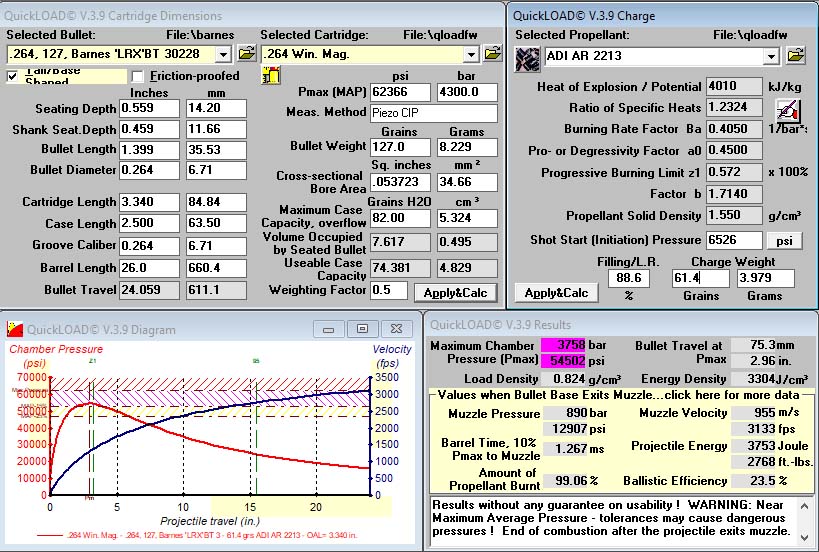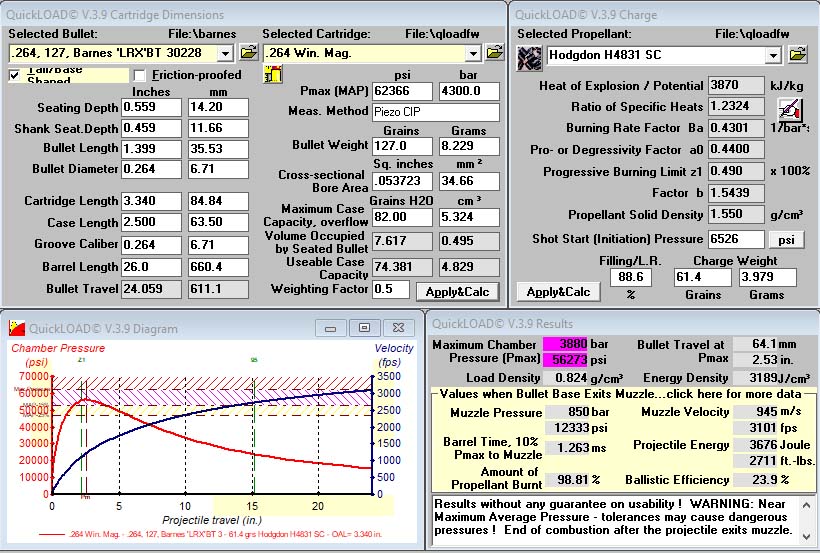Greetings Again,
I checked the Barnes on line data for the 127 grain LRX BT. They don't list H4831SC or H1000 (AR2213SC and AR2217 respectively) for that matter. They do list RL22 and IMR7828SSC (both slower than AR2213SC) at 58.3 and 56.0 grains max. The Hodgdon/ADI data is for the 129 grain Hornady Interlock. This is noted as a projectile developing less pressure than average while the Barnes projectiles develop notably more. Barnes even lists Retumbo (AR2225) at 62.7 grains max with the 127 grain LRX and this is way slower than AR2213SC. I am sorry to be the bearer of bad tidings but I think that the blow up was due to an overload. Barnes projectiles need special data with loading especially with the .264 Winchester which is known to be a bit grumpy at times. At least you didn't use Nick Harvey's 6th edition load of 68 grains. More than the rifle could have been scrap with that.
Regards and commiserations Grandpamac
Welcome guest, is this your first visit? Create Account now to join.
Welcome to the NZ Hunting and Shooting Forums.
Search Forums
User Tag List
+ Reply to Thread
Results 76 to 90 of 96
Thread: bolt failure P14
Hybrid View
-
26-12-2019, 12:48 PM #1Member

- Join Date
- Dec 2019
- Location
- Okawa Hawkes Bay
- Posts
- 3,177
-
26-12-2019, 01:46 PM #2
it seams to be the case, by switching to the barnes projectile from nosler lr 129gr i did not check the barnes site which had new data, last time i was on there there was no load data which could of been years ago. its not very well known or articulated just how different barnes bullets are to lead core copper jacket. thankfully i can walk away from this wiser, and able to help others not make the same mistake. @gundoc i seams through poor research i overloaded the old girl.
-
26-12-2019, 03:46 PM #3
@mucko I know you have posted load info in your original post and then bits thru the thread but would you mind reposting for both your previous load and the nasty Barnes stuff.
Also what is your barrel length, each load's catridge's OAL. I'm assuming you have jump as well?
Just playing with QL.
-
26-12-2019, 04:09 PM #4
i had used barnes before hand, then changed to nosler lr 129gr i had that load from 58.5-62.5gr in .2gr increments trim length 2.490 coal 3.184. i found nodes in the 59.5 and 61.5gr range. i then changed back to the barnes LRX
i (foolishly) did not check the barnes sight for new data. when i first built the rifle 6 years ago there from my recollection no load data (could be wrong) i have never successfully had the time to find a load to suit the rifle so it spend plenty of time hiding in the corner. if i did everything over and could advise anyone regardless of your powder recommendation check the requirement of the projectile maker.
-
26-12-2019, 04:13 PM #5
-
26-12-2019, 08:36 PM #6
-
26-12-2019, 08:51 PM #7
-
26-12-2019, 03:47 PM #8Member

- Join Date
- Dec 2019
- Location
- Okawa Hawkes Bay
- Posts
- 3,177
Greetings Once More Mucko,
I had the difference between the homogeneous and lead core projectiles recently when one of our club members had a near miss with his .260 rem with the same pill. He was about 2 grains over and his Sako escaped with no permanent damage. You mentioned a lack of pressure signs. Most of the standard ones such as primer appearance, bolt lift and ejector hole marks have been shown to be unreliable although some will dispute that. The best measure of pressure available to us mere mortals is the chronograph. Higher velocity means higher pressure. I use mine more and more. We are lucky that good modern pressure tested data is now available for the .264 due to Remington chambering it in their Sendero 700. Best of luck in your search for a modern action for your barrel. At least the Enfield barrel tenon gives you plenty of scope.
Regards Grandpamac.
-
28-12-2019, 02:06 PM #9
@mucko
2 QL images. The first using AR2213 which myself and some of my shooting mates know, well in QL at least, is not the same as AR2213SC.
Second image is Hodgdon H4831 which is AR2213SC.
Pretty basic analysis with more accurate results if measuring COAL and water capacity of a fired case.
QL can be brilliant or off the mark for some powders. Quite often you need to reverse engine QL to get relevant results ie fire a load, then adjust QL to match real world velocity.
So, what I have posted may not be gospel and other QL users may pick up something I have done wrong.
The pMax in QL is the max pressure rating of the cartridge case, not the action being fired. QL obviously has no idea of the strength of the action being used.
Did you have any velocities for your first shots fired?


-
28-12-2019, 05:12 PM #10Member

- Join Date
- Jul 2012
- Location
- North Shore Auck
- Posts
- 664
The Rifle seems to be operating in the range of pressures it can hold ? . That being the 276 enfield and 30-06 , and there where a lot of 30-06 fired out of P17's .
So what the question is what happened to the case ? . Because it all seems to point to what Gundoc has said with maybe some sort of case failure / maybe oversized / oil on case / something which contributed as a catalyst . With age cracking just behind the bolt ?????.
So is there any pictures of the case ? .
-
28-12-2019, 05:15 PM #11
-
28-12-2019, 07:11 PM #12
-
28-12-2019, 07:14 PM #13
i use imperial sizeing wax on cases then ultrasonic clean and air dry before i load them, clean primer pockets etc, loaded rounds are stored in mtm case. the case that was in the barrel apart from no arse end had no splits and no signs of gas blowing past the neck. will try get fresh pics up tomorrow.
-
28-12-2019, 07:43 PM #14Member

- Join Date
- Apr 2012
- Location
- Kingcountry
- Posts
- 5,039
For my 5 pence worth find that ADI have reduced their min-max loads by quite a bit over the last 30 plus years, I use their max load as starting load if I'm using different cases or projectiles from the norm, never struck a problem and most my loads are 3-4 grains above what they now class max in their reloading data, this is with medium - larger case capacities. Don't know what has happened here, go buy a lotto, you had luck on your side.
-
28-12-2019, 08:45 PM #15
yeah bloody lucky, hows TK these days. bloody interesting QL data. im eyeing up a sauer 100 in 300WM. need to move some other toys to achieve it thou. will sell the 3006AI with timmney trigger and dies as wont need it with 300WM may even sell the 6.5/06 but thats a maybe.
Similar Threads
-
Meindl Boot Failure !
By Scout in forum Gear and EquipmentReplies: 39Last Post: 01-10-2018, 12:37 PM -
Suppressor failure
By Dermastor in forum Varminting and Small Game HuntingReplies: 5Last Post: 07-12-2016, 08:19 PM -
suppressor failure
By Looseunit in forum Firearm SafetyReplies: 197Last Post: 11-08-2015, 11:27 PM -
Rule 5 Failure
By Happy in forum Firearm SafetyReplies: 2Last Post: 25-10-2013, 10:59 AM
Tags for this Thread
Welcome to NZ Hunting and Shooting Forums! We see you're new here, or arn't logged in. Create an account, and Login for full access including our FREE BUY and SELL section Register NOW!!





 99Likes
99Likes LinkBack URL
LinkBack URL About LinkBacks
About LinkBacks



 Reply With Quote
Reply With Quote



Bookmarks